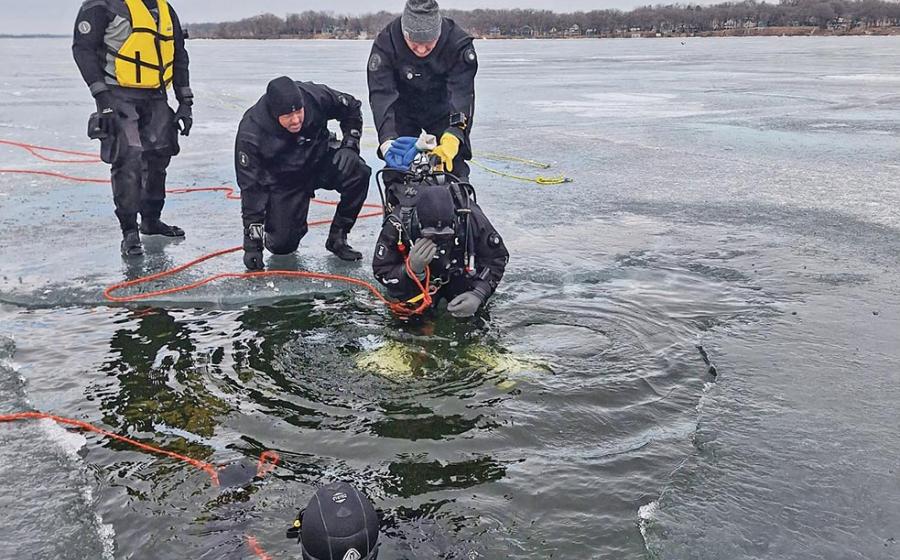Fishwatching 101

By Michael Ange and Travis Marshall
Divers are travelers, and like travelers everywhere, we love to learn about the things we see along the way. Let's face it--even great landmarks like the Washington Monument and the Statue of Liberty lose a lot of their appeal if you know nothing about them or their history. The same is true for dive sites around the world, and some of the most interesting features are the creatures you'll see on the reef. Sure parrotfish are fun to look at, but their mystique only grows when you learn unique details about them like the fact that they change sexes and colors as they age. If you're ready to start getting the most out of your diving experiences, a good fish ID course is the way to go.
Scuba Diving's friends Ned and Anna DeLoach and Paul Humann, who contribute the monthly "Encounters" column, are responsible for the Reef Environmental Education Foundation (REEF)--an organization that enlists divers to participate in marine life surveys and spreads conservation awareness through marine life education. Here's an overview of what their diver-friendly training program teaches to give you a head start on your future fishwatching opportunities.
The Name Game
One problem fishwatchers encounter is getting the names straight--and understandably so. Certainly it's pretty easy to communicate with a group about a snapper you saw on the dive, but when you start using more specific names, things can sometimes get confused. The gray snapper, for example, is also commonly called a mangrove snapper, and it would be easy for two divers to talk about the same fish using different names. To address this dilemma, REEF uses common names from the standardized list compiled by the American Fisheries Society.
But if you want to get really specific when talking about fish species, the Latin or "scientific" names applied to all organisms are a universal method (scientists of all nationalities use the same Latin names) for keeping the names straight. Scientific names are listed in a hierarchy of classification groups called the taxonomy order, starting with the most general, Kingdom (plant or animal), and ending with the most specific classification, species. For fishwatching purposes, learning the bottom three rungs of the taxonomy order will suffice.
Family--The general grouping, such as angelfish (Pomacanthidae).
Genus (always capitalized)--Groups within a family that share similar characteristics. Both the French and gray angelfish fall into the genus Pomacanthus.
Species (always lowercase)--The most specific name. This refers to the exact type within the genus. The French angelfish's species is paru; the gray angelfish's is arcuatus.
Together, the genus and species of any organism is called its "binomial (two-name) nomenclature," and that is the scientific name you'll see in fish ID books. Using the above examples, the French angelfish is called Pomacanthus paru, and the gray angelfish is Pomacanthus arcuatus.
What to Look For
When you're on a dive and you see a fish that you'd like to know the name of, there are two basic categories of identifying features to keep in mind when you look through an ID book later on.
A fish's basic markings are the colors and patterns on its body. REEF describes the following nine markings:
-
Bars--Bold lines that run vertically along the body.
-
Stripes--Bold lines that run horizontally along the body.
-
Bands--Bold lines that run diagonally along the body.
-
Spots--Well-defined, circular dot shapes.
-
Occelated spots--Spots with circular rings of another color around them.
-
Blotches--Irregular or poorly defined spots.
-
Radiating lines--Lines radiating from the eyes.
-
Speckles--Groups of small dots.
-
Lines--Thin markings of any orientation on any part of the body. The placement and shape of the different fins on a fish's body can also help distinguish a particular species. There are five primary fin groups:
-
Dorsal--The fin along the top or back of the body.
-
Tail--Also called the caudal fin.
-
Anal--Fin on the bottom rear of the body, below the tail.
-
Pectoral--Fins on either side of the body, positioned similarly to the arms or pectoral (chest) muscles on a person.
-
Ventral--Fin on the bottom forward part of the body.
-
The Tools to Use
When you're underwater, there are a number of tools you can take along to help you understand what you're looking at. Waterproof picture slates or flipbooks are a common sight on any dive boat. These usually have small illustrations or photos of common fish species, and you can carry them on the dive for a quick reference. For the serious fishwatcher, a blank or fish ID-specific slate with a pencil for underwater note taking can be especially helpful for tracking down an unknown species back on land. When you do find an unknown species, it's important to write down a description or make a rough drawing of the markings, making sure to note the size and shape of the different fins. Also write down the size of the fish and the depth and habitat where you saw it.
One Fish, Two Fish...
REEF teaches fishwatching with a purpose, and you can help make a difference by taking part in REEF's fish survey programs. There is a hierarchy of participation based on your fish ID education and surveying experience. Go to the store at reef.org or check your local dive shop for REEF's home-study course, which comes with everything you need to get started on your novice fish knowledge. Divers who really get into it can work toward the expert experience levels for opportunities to join in-depth monitoring projects and help train new fishwatchers.
Experience Levels
Novice
Level 1 Become a REEF member, complete the home-study course and pass the associated Most Common Fishes Quiz.
Level 2 Score 80 percent or higher on the Most Common Fishes Quiz and complete two fish surveys.
Level 3 Pass the Most Common Fishes Quiz and conduct 25 surveys. Taking part in a REEF Field Survey project often fulfills these criteria.
Expert
Level 4 Score 90 percent or higher on the Advanced Fishes Quiz and conduct 35 surveys.
Level 5 Score 95 percent or higher on the Advanced Fishes Quiz and conduct 50 surveys.
REEF's 12 Fish ID Groups
Group 1: Discs and Ovals/Colorful--Thin bodies with round or oval profiles, small mouths and generally bright colors.
Group 2: Silvery--Silver or gray fish with little to no markings.
Group 3: Sloping Heads/Tapered Bodies--A basic "fish-like" shape, large mouths and forked tails.
Group 4: Small Ovals--Small, less than 6 inches, with an oval profile.
Group 5: Heavy Bodies/Large Lips--Strong, heavy bodies, large mouths and lips and a jutting lower jaw.
Group 6: Swim with Pectoral Fins/Obvious Scales--Clearly swim with the pectoral fins and the individual scales are distinct to the eye.
Group 7: Reddish/Big Eyes--Nocturnal fish with a pale red to reddish brown color and big eyes.
Group 8: Small, Elongated Bottom-Dwellers--Long, cylindrical bodies no more than 3 inches long, often resting on the bottom or in small holes.
Group 9: Odd-Shaped Bottom-Dwellers--Camouflage experts with an atypical fish shape, usually found sitting on the bottom or reef.
Group 10: Odd-Shaped Swimmers--Swimming fish with an atypical body shape.
Group 11: Eels--Long, snake-like bodies.
Group 12: Sharks and Rays--Fish with cartilage skeletons and small, hard scales that form a sandpapery skin.

By Michael Ange and Travis Marshall
Divers are travelers, and like travelers everywhere, we love to learn about the things we see along the way. Let's face it--even great landmarks like the Washington Monument and the Statue of Liberty lose a lot of their appeal if you know nothing about them or their history. The same is true for dive sites around the world, and some of the most interesting features are the creatures you'll see on the reef. Sure parrotfish are fun to look at, but their mystique only grows when you learn unique details about them like the fact that they change sexes and colors as they age. If you're ready to start getting the most out of your diving experiences, a good fish ID course is the way to go.
Scuba Diving's friends Ned and Anna DeLoach and Paul Humann, who contribute the monthly "Encounters" column, are responsible for the Reef Environmental Education Foundation (REEF)--an organization that enlists divers to participate in marine life surveys and spreads conservation awareness through marine life education. Here's an overview of what their diver-friendly training program teaches to give you a head start on your future fishwatching opportunities.
The Name Game
One problem fishwatchers encounter is getting the names straight--and understandably so. Certainly it's pretty easy to communicate with a group about a snapper you saw on the dive, but when you start using more specific names, things can sometimes get confused. The gray snapper, for example, is also commonly called a mangrove snapper, and it would be easy for two divers to talk about the same fish using different names. To address this dilemma, REEF uses common names from the standardized list compiled by the American Fisheries Society.
But if you want to get really specific when talking about fish species, the Latin or "scientific" names applied to all organisms are a universal method (scientists of all nationalities use the same Latin names) for keeping the names straight. Scientific names are listed in a hierarchy of classification groups called the taxonomy order, starting with the most general, Kingdom (plant or animal), and ending with the most specific classification, species. For fishwatching purposes, learning the bottom three rungs of the taxonomy order will suffice.
Family--The general grouping, such as angelfish (Pomacanthidae).
Genus (always capitalized)--Groups within a family that share similar characteristics. Both the French and gray angelfish fall into the genus Pomacanthus.
Species (always lowercase)--The most specific name. This refers to the exact type within the genus. The French angelfish's species is paru; the gray angelfish's is arcuatus.
Together, the genus and species of any organism is called its "binomial (two-name) nomenclature," and that is the scientific name you'll see in fish ID books. Using the above examples, the French angelfish is called Pomacanthus paru, and the gray angelfish is Pomacanthus arcuatus.
What to Look For
When you're on a dive and you see a fish that you'd like to know the name of, there are two basic categories of identifying features to keep in mind when you look through an ID book later on.
A fish's basic markings are the colors and patterns on its body. REEF describes the following nine markings:
Bars--Bold lines that run vertically along the body.
Stripes--Bold lines that run horizontally along the body.
Bands--Bold lines that run diagonally along the body.
Spots--Well-defined, circular dot shapes.
Occelated spots--Spots with circular rings of another color around them.
Blotches--Irregular or poorly defined spots.
Radiating lines--Lines radiating from the eyes.
Speckles--Groups of small dots.
Lines--Thin markings of any orientation on any part of the body. The placement and shape of the different fins on a fish's body can also help distinguish a particular species. There are five primary fin groups:
Dorsal--The fin along the top or back of the body.
Tail--Also called the caudal fin.
Anal--Fin on the bottom rear of the body, below the tail.
Pectoral--Fins on either side of the body, positioned similarly to the arms or pectoral (chest) muscles on a person.
Ventral--Fin on the bottom forward part of the body.
The Tools to Use
When you're underwater, there are a number of tools you can take along to help you understand what you're looking at. Waterproof picture slates or flipbooks are a common sight on any dive boat. These usually have small illustrations or photos of common fish species, and you can carry them on the dive for a quick reference. For the serious fishwatcher, a blank or fish ID-specific slate with a pencil for underwater note taking can be especially helpful for tracking down an unknown species back on land. When you do find an unknown species, it's important to write down a description or make a rough drawing of the markings, making sure to note the size and shape of the different fins. Also write down the size of the fish and the depth and habitat where you saw it.
One Fish, Two Fish...
REEF teaches fishwatching with a purpose, and you can help make a difference by taking part in REEF's fish survey programs. There is a hierarchy of participation based on your fish ID education and surveying experience. Go to the store at reef.org or check your local dive shop for REEF's home-study course, which comes with everything you need to get started on your novice fish knowledge. Divers who really get into it can work toward the expert experience levels for opportunities to join in-depth monitoring projects and help train new fishwatchers.
Experience Levels
Novice
Level 1 Become a REEF member, complete the home-study course and pass the associated Most Common Fishes Quiz.
Level 2 Score 80 percent or higher on the Most Common Fishes Quiz and complete two fish surveys.
Level 3 Pass the Most Common Fishes Quiz and conduct 25 surveys. Taking part in a REEF Field Survey project often fulfills these criteria.
Expert
Level 4 Score 90 percent or higher on the Advanced Fishes Quiz and conduct 35 surveys.
Level 5 Score 95 percent or higher on the Advanced Fishes Quiz and conduct 50 surveys.
REEF's 12 Fish ID Groups
Group 1: Discs and Ovals/Colorful--Thin bodies with round or oval profiles, small mouths and generally bright colors.
Group 2: Silvery--Silver or gray fish with little to no markings.
Group 3: Sloping Heads/Tapered Bodies--A basic "fish-like" shape, large mouths and forked tails.
Group 4: Small Ovals--Small, less than 6 inches, with an oval profile.
Group 5: Heavy Bodies/Large Lips--Strong, heavy bodies, large mouths and lips and a jutting lower jaw.
Group 6: Swim with Pectoral Fins/Obvious Scales--Clearly swim with the pectoral fins and the individual scales are distinct to the eye.
Group 7: Reddish/Big Eyes--Nocturnal fish with a pale red to reddish brown color and big eyes.
Group 8: Small, Elongated Bottom-Dwellers--Long, cylindrical bodies no more than 3 inches long, often resting on the bottom or in small holes.
Group 9: Odd-Shaped Bottom-Dwellers--Camouflage experts with an atypical fish shape, usually found sitting on the bottom or reef.
Group 10: Odd-Shaped Swimmers--Swimming fish with an atypical body shape.
Group 11: Eels--Long, snake-like bodies.
Group 12: Sharks and Rays--Fish with cartilage skeletons and small, hard scales that form a sandpapery skin.












